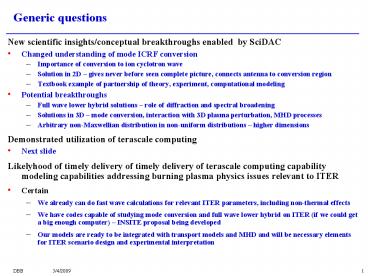Generic questions PowerPoint PPT Presentation
Title: Generic questions
1
Generic questions
- New scientific insights/conceptual breakthroughs
enabled by SciDAC - Changed understanding of mode ICRF conversion
- Importance of conversion to ion cyclotron wave
- Solution in 2D gives never before seen complete
picture, connects antenna to conversion region - Textbook example of partnership of theory,
experiment, computational modeling - Potential breakthroughs
- Full wave lower hybrid solutions role of
diffraction and spectral broadening - Solutions in 3D mode conversion, interaction
with 3D plasma perturbation, MHD processes - Arbitrary non-Maxwellian distribution in
non-uniform distributions higher dimensions - Demonstrated utilization of terascale computing
- Next slide
- Likelyhood of timely delivery of timely delivery
of terascale computing capability modeling
capabilities addressing burning plasma physics
issues relevant to ITER - Certain
- We already can do fast wave calculations for
relevant ITER parameters, including non-thermal
effects - We have codes capable of studying mode conversion
and full wave lower hybrid on ITER (if we could
get a big enough computer) INSITE proposal
being developed - Our models are ready to be integrated with
transport models and MHD and will be necessary
elements for ITER scenario design and
experimental interpretation
2
Demonstrated utilization of terascale computing
capability
AORSA jobs run last two weeks
There is usage of terascale computers
And there is effective usage of terascale
computers
AORSA is a JOULE code
3
Generic questions
- Specific steps to ensure more analysis of
simulation data - Relation of solutions to simple 0D/1D wave
concepts - Local modes
- Mode conversion
- Local damping or macroscopic force
- New fundamental concepts of wave plasma
interaction - Fair question we will have to think about
how to do this better - Code verification multiple code instance
AORSA/TORIC, CQL3D, Orbit/RF, direct orbit
integration in Rf fields - Code validation we have an ongoing program of
comparison with experiments - What would our ideal computer look like?
- We have many different mathematical operations so
we need a well balanced platform - We cant say whether vector vs MPP scalar is
better, yet not enough experience with new
vector architecture and we dont know where the
bottlenecks will be with integrated codes - There is an upper limit on memory/speed/run time
required for ITER, but we can only give gross
extrapolations as to what these are. - Reasonable turn around time
4
Specific questions
- What will we do to validate the quasilinear
approach? - Issue 1 decorrelation of particle orbits in RF
field solutions - Plug in numbers in Stix Chapter 14-17
- To explore other decorrelation mechanisms
direct orbit solutions and comparison - Issue 2 linearization of Vlasov-Maxwell system
that give the first order equations ? nonlinear
mode coupling - Probably ok in core plasma, likely not ok in edge
plasma where nonlinear effects may be present - Part of our edge/antenna component addresses this
Time dependent PIC simulation - Also a fair question that we will put some
thought into - Does bounce average include radial motion of fast
particles? - No CQL3D is a zero orbit width code (i.e.
particles stay on a flux surface). Both the
collision operator and the quasilinear operator
are bounce averaged with this assumption. AORSA
calculates velocity space diffusion coefficients
local in space and velocity space which are then
bounce averaged assuming no deviation from flux
surface - Plans for terascale computing applications beyond
linear dense matrix solve? - Dense matrix solve in no longer the dominant
computation load in AORSA - High resolution mode conversion calculations,
full wave lower hybrid - Integrated models AORSA/Fokker Planck,
TORIC/TOPICA, Edge/antenna integrated models

